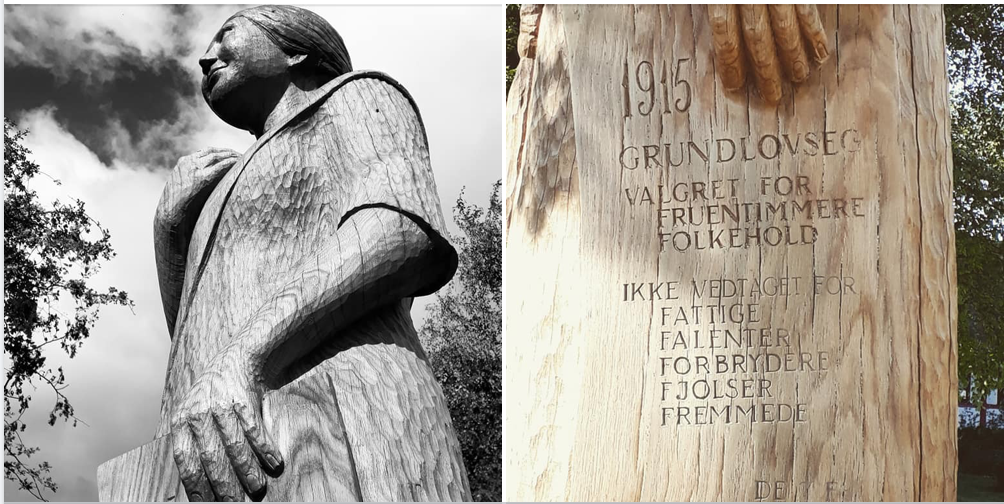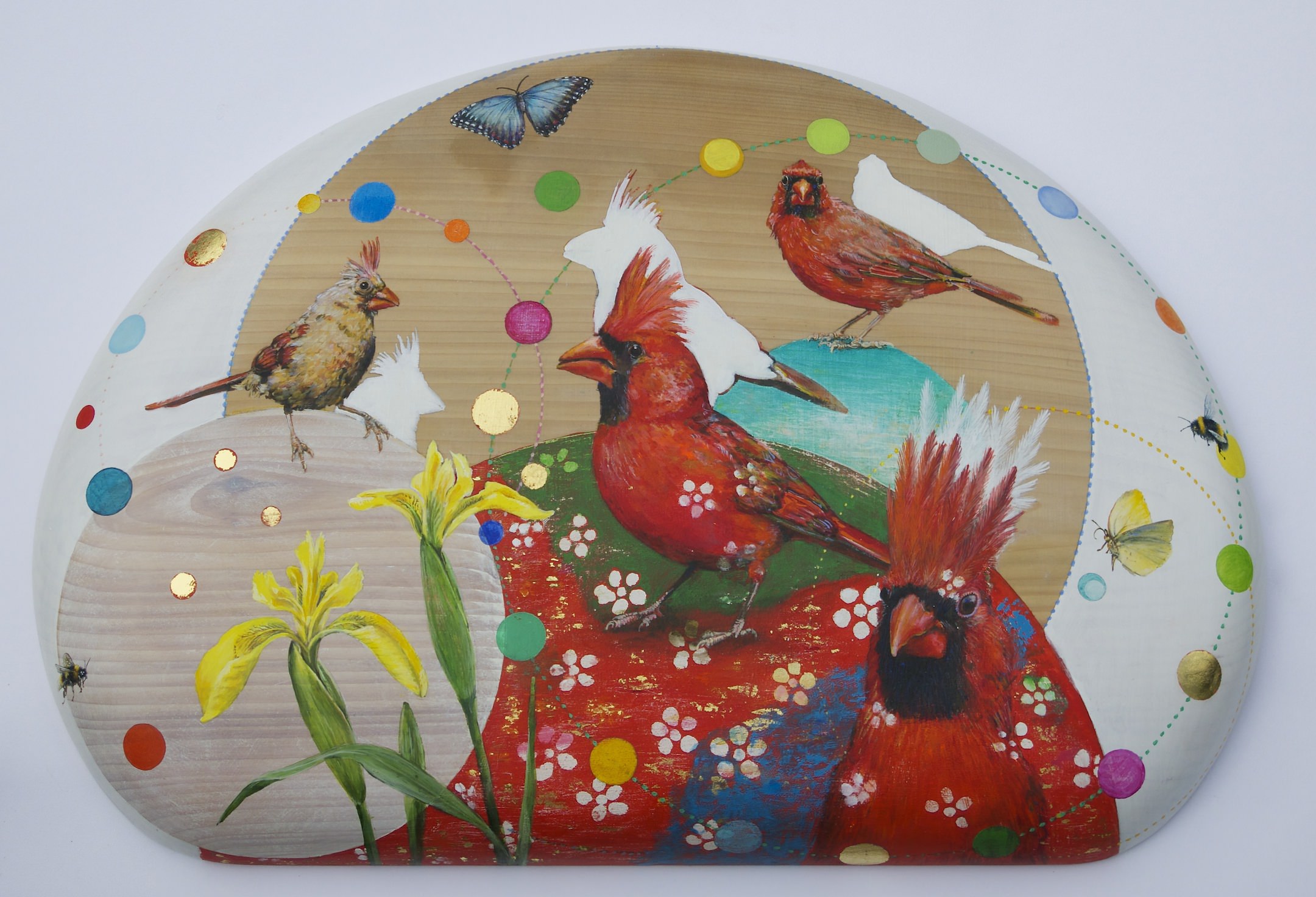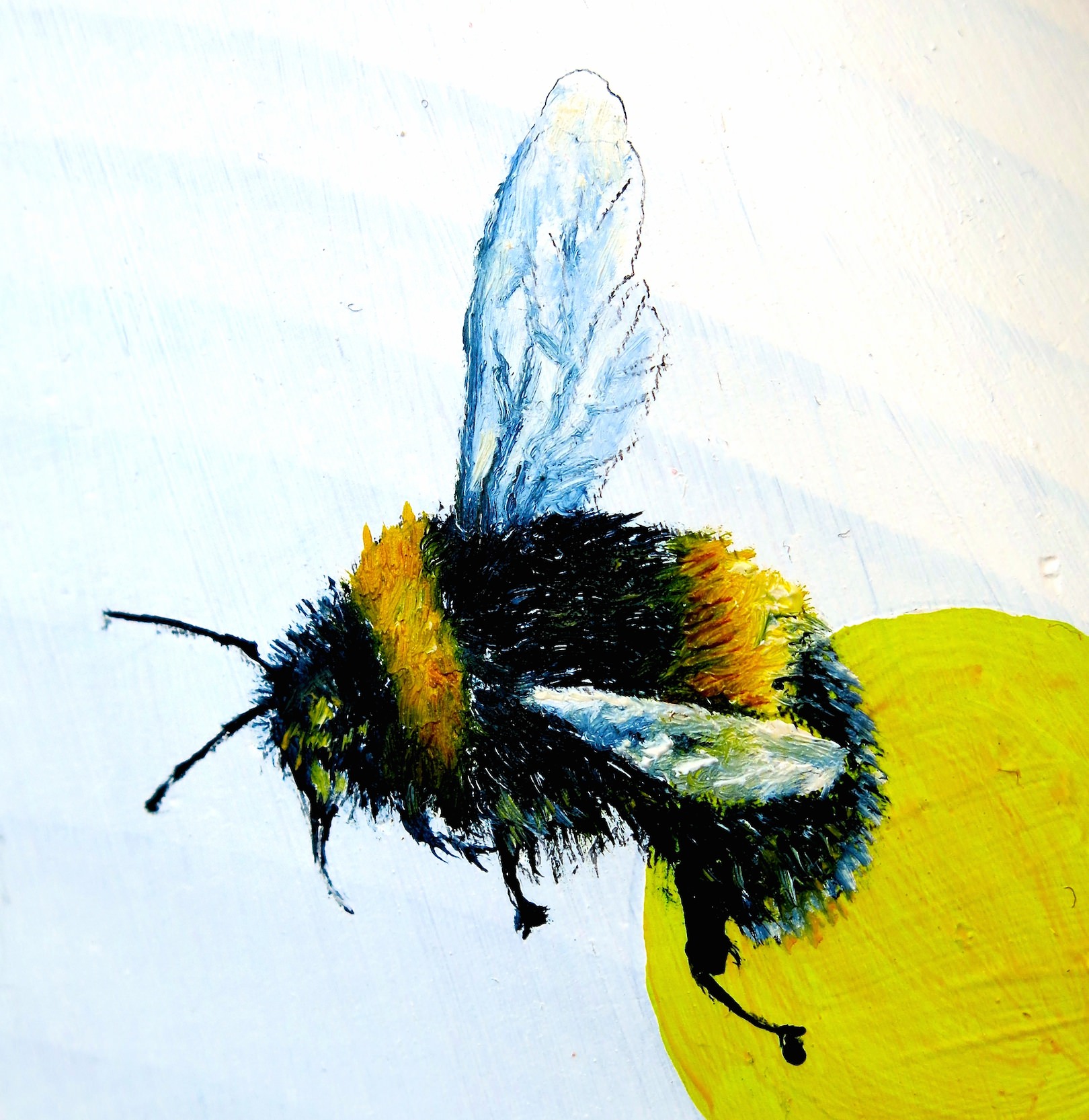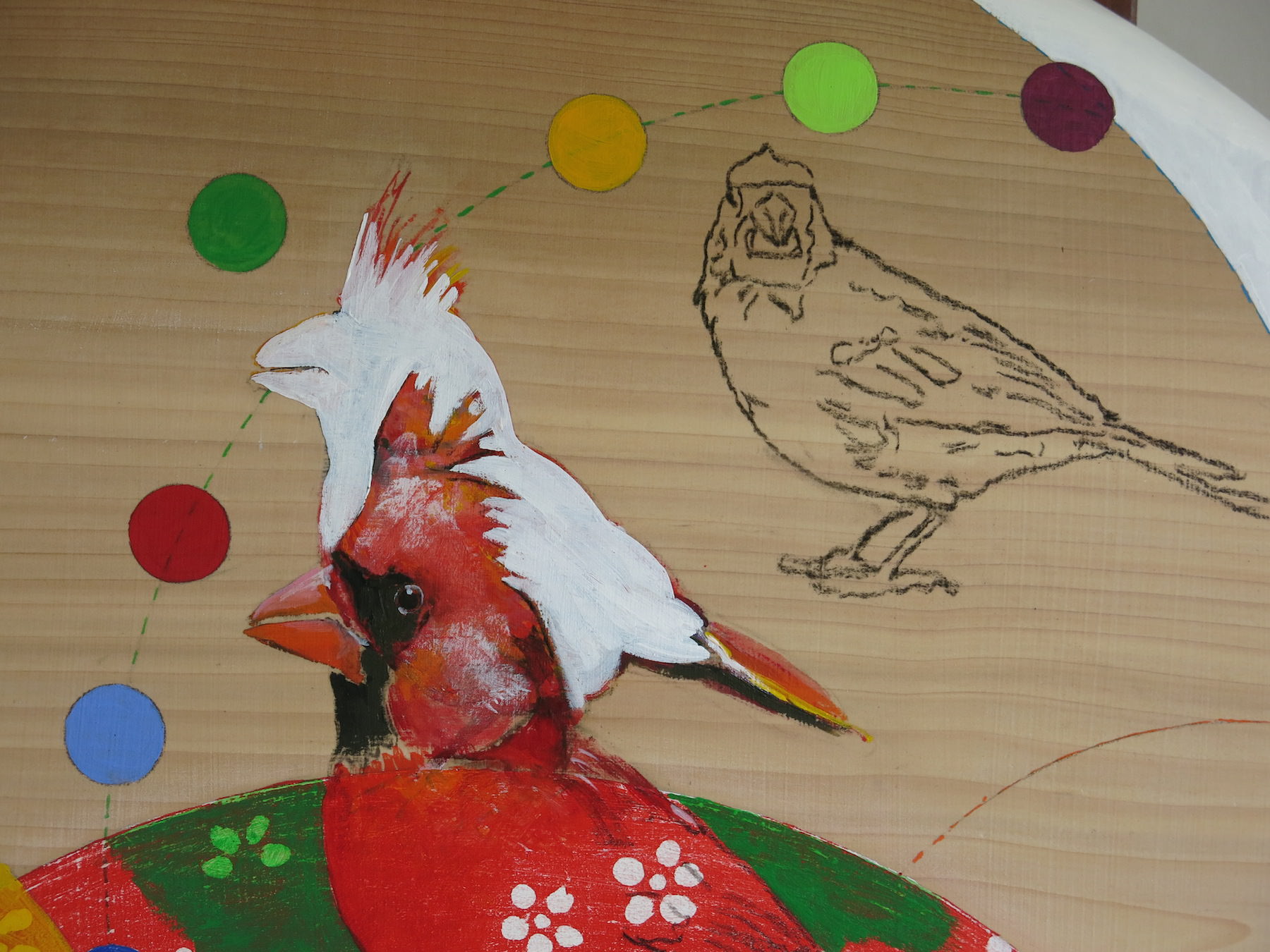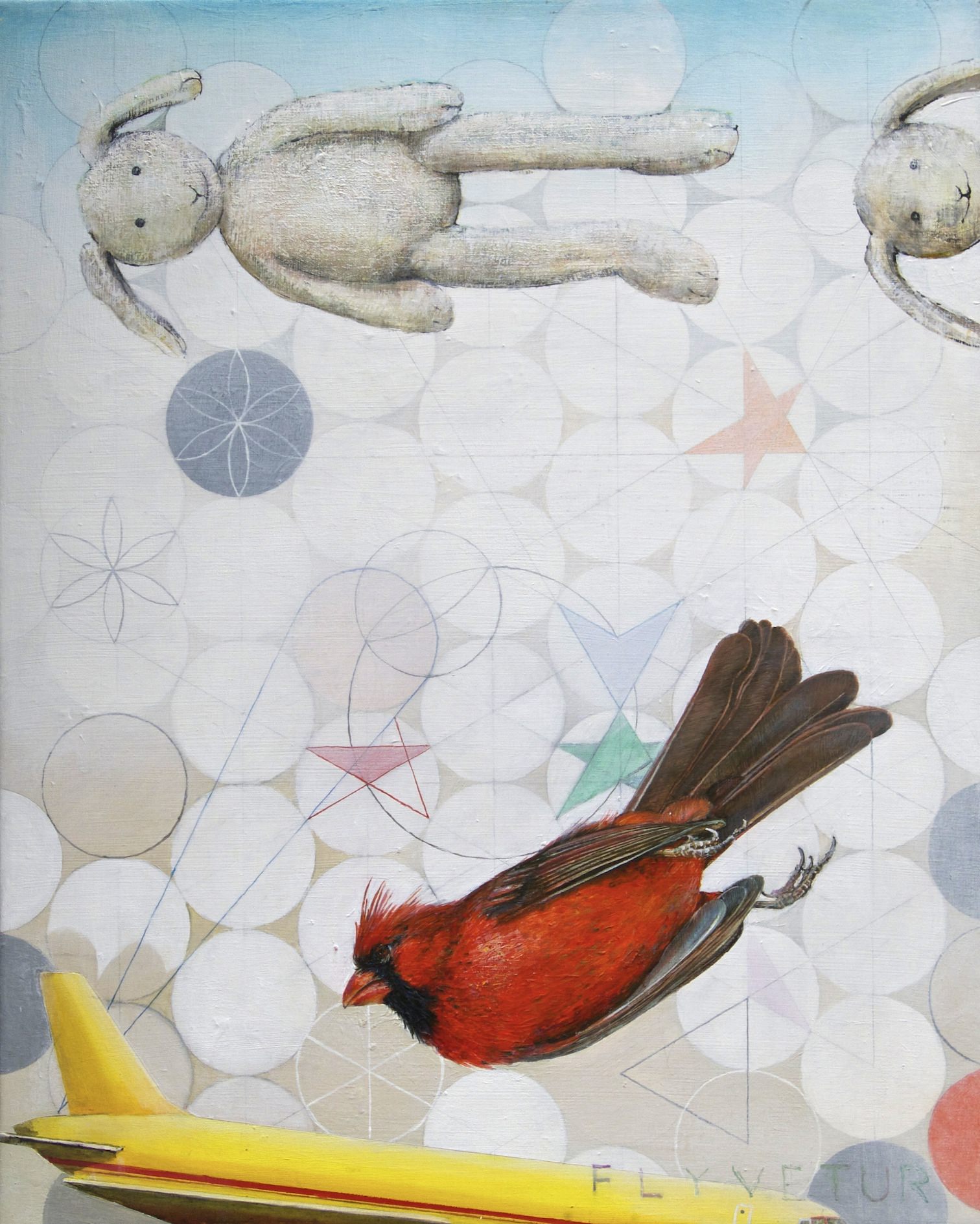Nyt lækkert egetræsskilt, lavet til "Jord Naturgård" i Torup. Et ca 60 cm langt skilt, sirligt udskåret i stenhårdt aldret genanvendt egetræ. Den flotte egeplanke er fundet nede i Veksø, hos nu afdøde Bjørn. Den har ligget ude i vejret i måske tyve år, er blevet "vejrbidt" så smukt som kun egetræ kan blive det. Overfladen ligner på det nærmeste "JORD", og 2mm under det vejrbidte lag, er det fineste sunde egetræ eksponeret ved hjælp af skarpe stemmejern og tålmodig skære-glæde.
Woman Oak Sculpture Carving
Work in Progess.
New painting called: "Circles"
I have been fascinated by the striking red color of the cardinal birds, I saw while visiting Hawaii a few years ago. Recently I finished this painting. It has a little gathering of cardinal birds, I have given it the name "Circles' - in the many meanings of the word. The painting is about summer, the time of the year where everything grows, the birds sings uttermost, and there is maximum activity in nature. Sebastian bought it and it is now hanging beautifully in his conservatory.
The painting is made with acrylic and oil colors on a shaped piece of danish grown Western Red Cedar wood. It measures 23 inches X 32 inches X 2,5 inches
Så blev det endeligt færdigt - maleriet med de røde Cardinalfugle. "Circles" hedder billedet - i ordets mange betydninger. Sebastian Nybo har købt billedet. Jeg er sikker på at det har fået en hjertelig velkomst i Sebastians hjem.
Det er et billede der handler om sommer - den tid på året hvor planterne gror og gror, fuglene synger og alt er maksimalt aktivt i naturen.
Billedet måler 57 cm i højden, 80 cm i bredden og 6 cm i dybden. Det er malet på et afrundet stykke thujatræ.
" Upside Down, Round and Round"
This painting was started a few years while I was spending a winter in Hawaii. A beautiful dead Cardinal bird - hit by a car and laying dead on the side of the road - inspired me to paint. Now the painting is done. I am calling it: "Upside Down, Round and Round".
Acrylic on canvas, 76cm X 61cm ( 30" X 24"), 2017
Save the Arctic
Happily I just finished this polar bear painting. I wish to donate money to help the arctic, when this painting sells. . .
Acrylic on canvas, 116,5 cm X 152,5 cm ( 46 inches X 60 inches), 2016
The painting is for sale at Gallerie Lorien, Copenhagen. http://gallerie-lorien.com
”101 kunstnere 2016”
Det brede opslagsværk over dansk nutidskunst
Onsdag den 14. september udkommer bogen ”101 kunstnere 2016”.
”101 kunstnere” viser et bredt udvalg afnogle af Danmarks mange dygtige malere, billedhuggere, keramikere, glaskunstnere og installationskunstnere.
Redaktøren af ”101 kunstnere” er Jyllands Postens kunstanmelder og Kunstavisens redaktør Tom Jørgensen.
Hovedpointen bag ”101 kunstnere” er atvise, hvor mange dygtige kunstnere, der findes rundt omkring i landet. Det kan være purunge talenter som garvede veteraner. Det kan være akademiuddannede kunstnere som autodidakter. Det kan være malere med stærke og ekspressive penselstrøg, og det kan være keramikere med et fint og æstetisk formsprog. Uanset hvad, er det alle dygtige kunstnere.
Samtidigt vil ”101 kunstnere” meget gerne få den enkelte læser til at gå på opdagelse i kunstens fantastiske verden uden tunge teoretiske afhandlinger hængende over hovedet.
Bogens kunstnere præsenteres i alfabetisk orden efter efternavn og hver kunstner har såvel en tekst- som en billedside.
Der vil desuden være oplysninger om kunstnerens adresse, hjemmeside og email.
”101 kunstnere 2016”
Pris: 200 kr.
Redaktør: Tom Jørgensen, tlf. 2589 3981, mail@eikon-kunstformidling.dk
PSH Forlag
Omslagsillustration: Tobias Mikkelsen
8. årgang. Oplag: 1000
ISBN: 978-87-994055-89
101 Kunstnere 2016
Here is my page in the book:
English Translation by me and Robert Lacey:
Hunting scenes are a common subject in the history of painting. We often see depictions of aristocrats bringing down a deer after dogs have chased the prey back to the hunter, or of dead ducks piled at the feet of pipe-smoking men on a Danish beach meadow.
Dee Wolff has turned this convention on its head with her painting “Hunter and Prey.” Here, an animal we normally expect to be the prey, a hare, is not the prey at all. Quite the contrary, the giant hare/woman reigns ominous above the four-eyed coyote, who shows all sign of submission to her. The predator/prey roles are completely reversed.
But there is more than a simple reversal of roles going on here. The hare itself violates our expectations regarding relations between human and animal, as well as hunter/prey: it is a human/hare, woman/beast, a disconcerting twist that somehow drives the reversal of hunter/prey roles. We might think of ourselves as the masters of beasts, but we do not necessarily understand the source of our power.
Moreover, such paintings are clearly not just protest pictures against hunting. Dee Wolff’s animals are not cuddly or harmless; she captures their menacing, brutish qualities as much as their beauty –without the “Disney” vision of all things fuzzy and cute – and at the same time portrays the folly of those who “fuzzify” animals in this way.
In the painting “Dark,” for example, a large black dog licks his chops, in perilous proximity to the delicious little poodle who stands beside him. But this poodle is also a woman, this time in what appears to be the prey position –perhaps a warning to those who think of pets as four-legged children rather than the animals they actually are.
This painting also presents two distinct visions of nature. We see the humanized, or “fuzzified,” version in the lower part, where the scenery comes through an automobile’s mirror, a tiger is contained by a zoo, and a foolish woman kneels next to some letters. This is the world of human delusion. In the upper part, by contrast, we see nature open and uncontained. Here there is no containment or sentimentality –only a vast horizon and untamed flight. Notice that the head of the dog appears to reach into the upper zone, as if to suggest it is still a wild animal at the core of its being.
Such duality is characteristic of much of Wolff’s work. It appears in “The Eye of the Owl,” where the monumental eye projects a feeling of something compelling and magnificent on the one hand, but sinister and surreal on the other. It appears in “Boy and Red Ball,” where normal proportions are reversed, and in “Pitbull,” where a member of this infamous breed is portrayed as an ordinary mother animal. After all, the animal is never the real issue; it is always the human angle that creates complications.
Ultimately, we are part of nature. The implication seems to be that when we pacify or “Disneyfy” nature, when we see it only through the mirrors of human delusion, we confuse our understanding not only of nature, but of our own natures and our own place in the world.
Perhaps “Wooden Relief with Hare Head” reveals most starkly what Dee Wolff does with her art: she counters a humanized animal world with an animalized human world, and so invites us to reconsider and rediscover our lost connection with nature, and thereby, with ourselves.
Written by tom Jørgensen, art reviewer
In the section "Fra Thule til Gedser", Copenhagen based foto-journalist, Tina Løkke made this little note about my ZigZag reliefs.
"Famililiejournalen" nr. 32, 2016
I "Familiejournalen" denne uge / Small article in weekly magazine
ZigZag Wood Relief
My ZigZag pieces are now to be seen and purchased in Gallerie Lorien, Copenhagen: http://www.gallerie-lorien.com
- and in Designer Zoo, Copenhagen: http://www.dzoo.dk
Making a ZigZag wall piece
January 25, 2016
After having found the perfect piece of Ponderosa pine in the firewood pile, this is how I start a Zigzag wall piece. With an axe working my way in to a square piece of wood.
With my japanese precision saw I start cutting out the first triangle.
This wood has such a beautiful color. The heartwood in the middle is a nice pinkish color while the sapwood has this darker blue gray tone. This blue gray color comes from blue stain fungus. It's really beautiful and will not decay, now that I have taken it out of the rain to dry properly. The wood comes from a dead tree, and sometimes one can be lucky to find the wood when it has exactly this color. Not to much and not to little.
After having shaped the wood into a ZigZag wall relief by cutting from both sides, and sanded it smooth and nice, I let it absorb lots and lots of linseed oil. That will prevent it from drying to fast and cracking.
Close to finished ZigZag piece.
Making another Ponderosa Pine wood ZigZag relief. This one is made with heart wood only, no sapwood.
Working with my amazing new japanese saw.

